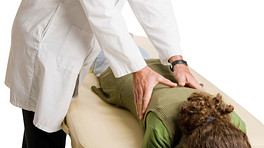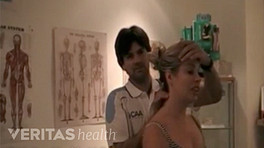The thoracic spine may be manipulated in prone, supine, or side posture. The prone position is the most commonly used. In this position, we apply contacts over the transverse processes of the thoracic vertebrae and apply pressure directly on that fulcrum. The patient is then asked to take in a deep breath and as they exhale, we apply pressure to slowly bellow the air out of the patient. At the end range, a slight impulse is then applied.
Lower thoracic manipulations might require the patient to be placed in a side posture position. By applying counterforce to the vertebra above the functional legion, the motion segment can be better isolated. Slight distraction to be applied by asking the patient to shrug their shoulders while the manipulation is administered through a hooked finger contact at the vertebra below.
Another common thoracic spine manipulation is performed in the flexion position. The cupped hand is placed over the spinous processes and the patient is asked to take in a deep breath. As the breath is expelled, the patient is lowered to the exam table and a high-velocity, low-amplitude impulse is then applied.
In This Article:
- Chiropractic Care of the Upper Back
- Chiropractic Treatment for Myofascial Pain Syndrome
- Chiropractic Treatment for a Thoracic Disc Herniation
- More Chiropractic Treatments for Upper Back Problems
- Chiropractic Adjustment of the Thoracic Spine (Upper Back) Video











